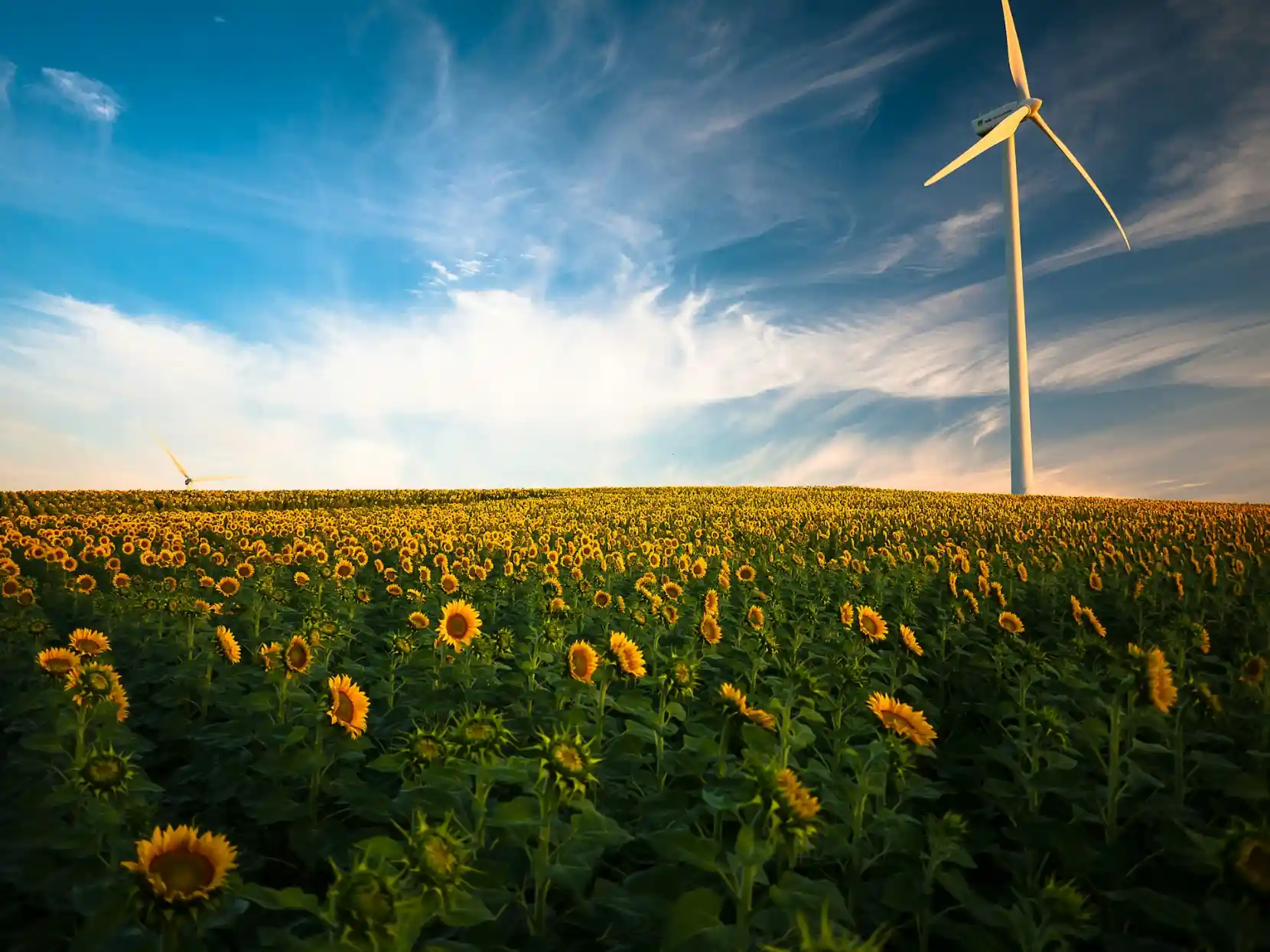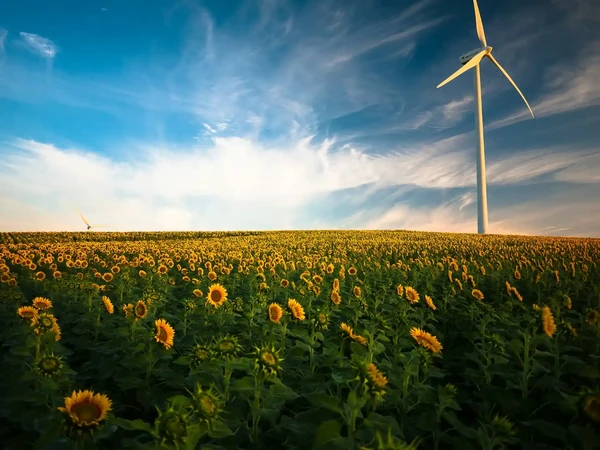
Investments in RES - How to invest in green energy?
Investment in onshore wind farms or photovoltaic panels is distinguished by a very large capital expenditure (CAPEX). This means that in most cases the developer of such an installation will apply for financial support from financial institutions, which need to have some collateral in order to decide to invest funds for a given green venture.
There are several incentive schemes aimed at supporting RES energy producers, which can directly or indirectly affect the price of energy or the energy mix of a given enterprise:
- Property rights (certificates of origin) in Poland,
- Guarantees of origin,
- long-term supply contracts (PPAs).
PROPERTY RIGHTS (Polish scheme)
Property rights are an instrument for supporting electricity from renewables and energy efficiency. The RES property rights market has been in operation since 2005 and allows generators and entrepreneurs to sell their property rights profitably. The listing of property rights is a separate category of energy products on the Polish Power Exchange (POLPX), with sessions taking place on Tuesdays and Thursdays.
The set of property rights that are part of the electricity bill consists of three certificates:
- green certificates (PMOZE_A),
- blue certificates (PMOZE_BIO),
- white certificates (EFF).
Purchasers of the property rights are companies that sell electricity, gas and heat to end users, which are under a statutory obligation to redeem certificates of origin. These entities have a choice between obtaining such certificates and presenting them for redemption to the President of the Energy Regulatory Office, or paying a so-called replacement fee.
Each year, the Ministry of Climate and Environment (MoE) sets the percentage share of the obligation, i.e. the volume of energy resulting from property rights, for the following calendar year. For 2024, the statutory share of certificates is set at 5% for the green certificate, 0.5% for the blue certificate and 1.5% for the white certificate.
Green certificates
Green certificates are obtained through the purchase and redemption of renewable energy certificates of origin and are an important source of revenue in addition to energy sales for generators of electricity from wind, hydro, geothermal, solar, biomass combustion, co-firing. They are essential for determining the profitability of renewable energy production for generators who commissioned their installations before mid-2016 and did not choose or were unable to switch to the implemented auction system.
Certificates of energy origin are issued by the President of the Energy Regulatory Authority and confirm that electricity was generated from renewable energy sources. The support system covers generators of electricity from renewable energy sources who produced green energy for the first time before July 1, 2016. The certificate of origin for electricity is entitled for a period of 15 consecutive years, but no longer than until December 31, 2035. This period is calculated from the date of first generation of this energy, confirmed by the certificate of origin issued.
According to Article 44.1 of the Law on Renewable Energy Sources, "A generator of electricity from renewable energy sources (...) and a generator of electricity from renewable energy sources in a renewable energy source installation other than a micro-installation, in which electricity was generated for the first time before the effective date of Chapter 4 [July 1, 2016, editor's note], shall be entitled to a certificate of origin for such energy confirming its generation from renewable energy sources, hereinafter referred to as a "certificate of origin."
Renewable energy producers in installations with a total installed capacity of more than 5MW, using hydropower to generate this energy, are not entitled to certificates of origin (Renewable Energy Act, Article 44(11)).
A renewable energy certificate confers property rights, which are transferable and constitute an exchange commodity. Each certificate of origin is transferred by the ERO to the Certificate of Origin Register maintained by the Polish Power Exchange (POLPX). Once a certificate is recorded in a registration account in the Registry, property rights are created, which an energy generator can sell on the Property Rights Market, e.g. to trading companies as "green certificates."
The essence of the creation of green certificates is the obligation to purchase them imposed on energy companies, as energy producers are obliged to produce a portion of their energy from renewable sources. The mandatory inclusion of renewable energy in the energy mix offered by trading companies plays a key role in shaping the demand for green certificates.
Currently, we are witnessing a gradual phasing out of this support system, as the mandatory share of individual certificates decreases every year. According to the Climate Ministry's 2021 assumptions, the supply of certificates of origin will decrease due to the decreasing number of generators using this support system.
In September 2023, the IOC announced a drastic reduction in the obligation to redeem green certificates for 2024 from the planned 11% to 5%. In 2023 the share was at 12%, in 2022 18.5% and in 2021 the share was 19.5%.
The rationale behind the decision to reduce the mandatory share of PMOZE_A so significantly was the desire to ease the burden on end users due to the high cost of electricity. Associations supporting RES generators and the generators themselves, for whom such a large reduction could affect the collapse of the green certificate market, took a different view.
As a result, in the first session of the POLPX after the announcement of the draft amendment to the regulation, the price of green certificates fell by nearly 50% - from 163.87 PLN/MWh to 82.50 PLN/MWh. This was the largest single drop in green certificate trading in the entire history of its listing. At the time of writing, prices are hovering around PLN 50/MWh, which translates into a cost of green certificates of about PLN 2.5/MWh in our electricity bill.
Blue certificates
Under the 2016 amendment to the RES Act, blue certificates were introduced as a separate RES obligation for energy from agricultural biogas plants. The separation and division into green and blue certificates were intended to affect the profitability of operating agricultural biogas plants, which were no longer profitable as a result of the drastic drop in the price of green certificates (as a result of the imbalanced oversupply of green certificates).
The legislator clearly defined the proportion of certificates, indicating that the obligation to obtain and present for redemption to the President of the ERO certificates of origin is considered fulfilled if the quantitative share of the sum of electricity resulting from the redeemed certificates is currently 5% for the "green obligation" and 0.5% for the "blue obligation," respectively (effective from 2018, in 2016 it was 0.65%).
The obligation to obtain and present redemption certificates of origin for energy from agricultural biogas plants is imposed on the same companies as for the green certificate. For energy from agricultural biogas plants. The current price of the blue certificate fluctuates around 300 PLN/MWh, as the maximum value of the substitution fee for both the green and blue certificates is 300.03 PLN/MWh.
White certificates
White Certificates, or officially Energy Efficiency Certificates, is a Mechanism for Supporting Energy Efficiency Investments provides additional funds for energy efficiency projects. It was introduced under the Energy Efficiency Law of April 15, 2011, and the current system was updated by the Law of May 20, 2016. Unlike , "green" and , "blue" certificates, , "white" certificates are awarded to beneficiaries not for energy generation, but for energy reduction through measures leading to energy efficiency.
Article 10 (1) of the 2016 Law on Energy Efficiency requires companies selling electricity, heat or gaseous fuels to end users to:
(a) implement an energy efficiency improvement project at the end-user, or
(b) obtain/purchase white certificates, which they will present to the President of the Energy Regulatory Authority for redemption.
Alternatively, the entity obligated to redeem energy efficiency certificates may also fulfill the obligation by paying a replacement fee. By law, the obligated entity may fulfill the obligation with a substitution fee if it did not acquire property rights from energy efficiency certificates in session transactions during the calendar year to which the obligation applies due to the fact that the price of property rights from these certificates was higher than the unit substitution fee for the year in question, or due to an insufficient number of offers of these rights.
The unit replacement fee for each year shall increase by 5% over the amount of the replacement fee in effect for the previous year. The replacement fee for 2023 was PLN 2010, and in 2024 it is already PLN 2110. In turn, one ton of oil equivalent (toe) saved is currently valued at around PLN 2140 at POLPX.
White certificates are official documents verifying energy efficiency gains of a minimum value of 10 tons of oil equivalent (toe), achieved by reducing energy consumption in implemented projects. Enterprises can realize savings through specific actions.
Article 19 (1) of the Energy Efficiency Law specifies energy correctness projects, these include projects involving thermal modernization, insulation, equipment replacement, lighting modernization and energy recovery from industrial processes. White certificates are granted for planned activities that require an energy efficiency audit before submitting an application to the Energy Regulatory Authority. Details on the preparation of the audit and methods for calculating energy savings are set forth in the Energy Minister's Decree of October 5, 2017.
White certificates have a monetary value, with no upper limit of support through trading and sale on the Polish Power Exchange, where the value is determined by the amount of energy saved. Their purpose is to compensate for the costs incurred for energy efficiency investments. The certificates confirm that the company has taken steps to improve energy efficiency, and the greater the planned energy savings, the greater the subsidy will be.
Entities that are particularly eager to undertake projects aimed at reducing energy consumption as a result of energy efficiency improvements include: local government units, cooperatives, housing communities, hospitals and individual entrepreneurs.
Guarantees of Origin
The rise of sustainability and ESG reporting requirements have made guarantees of origin more popular recently. This is because, with them, entities can demonstrate that a certain amount of energy has been produced from renewable energy sources, thus having the opportunity to confirm to customers and business partners that their operations are conducted with respect for the environment. Creating a green supply chain is becoming one of the key ways to increase the attractiveness of companies in both domestic and international markets. Hence, by acquiring a guarantee of origin, companies are better able to tailor their offerings to meet customer requirements or for a specific certification.
Companies using large amounts of electricity resources that receive compensation for energy price increases often use guarantees of origin to demonstrate reductions in greenhouse gas emissions. In 2022 alone, 39 of the 65 companies reporting to the Energy Regulatory Authority chose to do so.
It is crucial to clarify that having a guarantee of origin does not automatically confirm that the electricity physically consumed by a company comes exclusively from renewable energy sources. Instead, it certifies to the consumer that the amount of electricity fed into the grid by the generator, as specified in the guarantee, comes from RES. It is also worth noting that a company wishing to purchase guarantees of origin for all or part of the volume of energy consumed does not have to change its electricity or heat supplier.
How does the system of guarantees of origin work?
In Poland, the guarantee of origin system operates thanks to the amendment to the Energy Law adopted in 2014, which implemented selected assumptions of the 2009 EU RES Directive, including those concerning the guarantee of origin mechanism.
The genesis of this system of support for RES generators in the form of guarantees of origin was to ensure that they would receive additional financial benefits from the introduction of green energy into the grid.
The process of issuing a guarantee of origin begins when a green energy generator applies to the distribution or transmission operator in whose area of operation the RES installation is connected. The application must be submitted within 30 days from the date of completion of the generation of a given amount of electricity covered by the application.
After the operator approves the application, the application and the data from the metering and billing equipment on the amount of energy injected into the grid, within 30 days of receiving the application from the generator, are submitted to the President of the Energy Regulatory Office (ERO). On this basis, the ERO President issues guarantees and transfers them to the Guarantees of Origin Register.
Guarantees of origin are traded on the POLPX, which serves as a trading platform for producers and companies. Green energy producers have the option to sell guarantees of origin to larger energy suppliers or intermediaries, while companies can buy them to show their commitment to using green energy.
If a company has purchased guarantees of origin for part or all of its volume, the guarantees must be redeemed at the Register of Guarantees of Origin (RGP). This happens at the request of the entity (e.g., trading company, broker) that sold them to the company, to the POLPX for redemption.
As a result, the enterprise receives an electronic certificate, which has an individual number and the data of the entity in whose favor the guarantee of origin was redeemed.
Redemption of the guarantee of origin can be compared to the punching of a ticket, which, once purchased and punched, has its number. The document also has information on the source of the energy and the volume covering the certificate, with an accuracy of 1 MWh. Guarantees of Origin are valid for 12 months from the date of issue.
Technologies covered by the support system
Until now, Guarantees of Origin only certified the introduction of a certain amount of green electricity generated from wind, solar, hydro, and biomass. However, under the Renewable Energy Act of August 17, 2023, the range of possibilities for green energy producers to obtain guarantees of origin has been expanded.
As stipulated in Article 120 of the Renewable Energy Sources Act, as of January 1, 2024, guarantees of origin can no longer be issued not only for electricity generated from renewable energy sources (RES), but also for: biomethane, heat, or cooling, renewable hydrogen, biogas, and agricultural biogas.
Thanks to new technologies, the understanding of RES installations has expanded, and consequently, the number of generators who would like to obtain guarantees of origin for their installations has expanded.
Prices for guarantees of origin
As mentioned above, guarantees of origin are traded, and the POLPX acts as a platform for trading them between RES generators and trading companies or intermediaries. Prices are shaped based on supply and demand, among other factors, and trading takes place through the over-the-counter (OTC) market.
The weighted average price of guarantees of origin for electricity generated from Renewable Energy Sources in January 2024, was at 14.91 PLN/MWh, a decrease of 7.62 PLN/MWh compared to the previous month.
Record levels of guarantees of origin were recorded in October 2023, when the average price was at PLN 24.66/MWh. These were the highest prices in the nearly 10-year history of guarantees of origin trading on POLPX.
Why was there such a large price difference between October and January?
Since the beginning of the year, there has been a noticeable increase in the trading of guarantees of origin on the Polish Power Exchange, as the price caps imposed by the government in connection with the Law on Emergency Measures to Curb Electricity Prices are no longer in effect. Under the caps, most (up to 97%) of the revenue generated from the sale of guarantees of origin had to be returned by generators to the Price Difference Payment Fund, from which shield mechanisms for energy consumers were financed during the period December 1, 2022 to December 31, 2023. The lifting of the cap in the current 2024 increased the amount of available guarantees of origin from 2023 and thus influenced the record January turnover of 7.35 TWh. Comparing this result with December 2023, when volumes stood at 2.26 TWh, we see a significant increase.
The results in the last month of last year also indicated a 57.2% decrease in turnover compared to December 2022.
A Step Toward Harmonization - Joining the Association of Issuing Bodies (AIB)
The amendment to the RES Act also gives Poland the chance to become a member of the Association of Issuing Bodies (AIB), an international association that develops the market for and trades European guarantees of origin. The AIB brings together bodies designated by the government to administer the guarantee of origin (GO) system for electricity.
In practice, this would mean, the possibility for Polish companies to acquire guarantees of origin for green energy, which would not necessarily be produced in Poland. As a result, guarantees of origin purchased in foreign markets would be considered as valid as those purchased in the Polish market.
Currently, the AIB is composed of 36 members from 28 European countries, which include member states from the European Union, the European Economic Area, and the Energy Community. Only bodies designated by the government to administer the guarantee of origin (GO) system for electricity belong to the association. Poland, Bulgaria, and Romania are the last European Union countries that are not members of the organization.
Being part of this global association structure could increase the availability of guarantees of origin in international markets, contributing to price stabilization and greater transparency.
In addition to the formal aspects of the international exchange of guarantees, the involvement of the ERO President in the AIB could affect Poland's attractiveness to foreign investors, being an important factor in investment decisions.
Currently, however, there is no information on when Poland could join AIB.
Guarantees of Origin vs. Certificates of Origin - Key Differences
Guarantees of origin can easily be confused with certificates of origin. The feature that distinguishes certificates of origin from guarantees is that no property rights arise from the guarantee of origin. As stated in Article 120 (3) of the RES Act, "The disposal of guarantees of origin shall take place independently of the trade in property rights arising from certificates of origin."
In addition, the acquisition of guarantees of origin by companies results from their individual decision or strategy. Covering part or all of the volume represents an additional and voluntary cost towards the achievement of sustainable development goals. While the cost of property rights, including certificates of origin from renewable energy sources, is a mandatory cost included in the electricity bill, resulting from statutory obligations imposed on electricity trading companies, among others. The following illustration is provided to illustrate this fact:
Corporate and Virtual Power Purchase Agreements
The green power contracting market is undergoing significant growth and development as corporations adapt to a rapidly changing reality. Sourcing green energy remains a key challenge and opportunity in the current state of the Polish electricity market. Energy consumers are becoming increasingly aware of the environmental impact of corporate activities, resulting in a growing demand for methods to reduce it. One effective solution in this regard is to enter into corporate PPA (cPPA) or virtual PPA (or financial, vPPA). Such agreements allow the direct purchase of electricity from RES generators. What characterizes c/vPPA’s is their long-term nature, as they are usually for 10 or 15 years. This mechanism makes it possible to feel that the energy the entrepreneur is actually buying comes from renewable energy sources.
For the consumer, a c/vPPA gives price certainty over the long term, however, it is worth noting that price certainty is not the same as a guarantee of a lower price than in traditional electricity purchases, and price certainty depends on the model adopted, and in the end there is no guarantee that the final price will continue to be attractive to us. For this reason, buyers usually sign a c/vPPA securing only a portion of their electricity needs. In addition, PPA’s allow organizations to demonstrate their pro-climate actions by reducing carbon emissions and contributing to zero-carbon targets, which can affect their competitiveness. For the developer, the c/vPPA increases the chances of obtaining financing for the development of renewable energy generation facilities, as the c/vPPA provides the developer with the "bankability" of the project.
In recent years, we have noticed increasing interest among companies in such long-term agreements. From 2018 to October 2023, more than 60 PPAs were signed in Poland. In 2018-2020 there were 12 agreements; in 2021. - 15; in 2022. - 17; and in 2023 more than 20 were registered. According to available data, the total volume of energy in signed contracts is already more than 5.2 TWh/year.
PPA models
The transactional model involves the sale or purchase of energy, where the generator of electricity from a renewable source directly enters into a contract with a customer and settles with the customer for the energy produced. In the case of other sources, such as coal or gas, sales would have to be made through the Polish Power Exchange.
Consequently, energy sales based on cPPAs are mainly in the corporate sector, as is evident in the name of the contract with the prefix "corporate" (corporate PPA), but the name cPPA also can be used to tell that we are talking about a physical delivery of the green electricity.
However, the PPA covers all the terms of the contract, such as the amount of electricity to be supplied, the negotiated price, what risks are borne, the required accounting rules and penalties in case of default. Since it is a bilateral contract, the PPA can be tailored to the preferences of the parties involved, so the supply contract can take different forms.
A common feature of the different types of contracts is the agreement between the RES power generator and the customer The main difference is that not every contract entails a physical transfer of energy; it can also be executed virtually. It is also worth noting that regardless of the form of the PPA chosen, there is always an exchange of guarantees of origin between the parties.
Physical and financial or virtual PPA
A PPA with physical delivery (cPPA) is based on the direct sale of electricity from the generator to the customer via electricity grids. The price of energy generated by the power plant is fixed or adjusted through a mutually agreed formula. In this scenario, the customer enjoys the benefits of long-term energy security at an agreed price.
This type of contract assumes that the physical delivery of energy is realized, that is, the customer's energy needs are covered in real terms. Since the customer's actual energy consumption does not always coincide with the hourly generation profile of the RES source, a balancing of the energy surplus or shortfall is needed.
A virtual PPA (vPPA, also called a financial PPA) is a de facto settlement of a differential contract between a RES generator and a customer with physical delivery between the customer and the trading company. However, there is no physical delivery between the generator and the customer. The generator sells the volume of electricity generated on the wholesale market or to a selected trading company, and the buyer receives this volume under a contract with its seller. The buyer and the green power generator settle financially, based on a predetermined strike price and the chosen underlying instrument, e.g. the SPOT market (Day-Ahead Market listed on POLPX). According to the nature of the Contract for Difference, if the market price at which the generator sold the generated energy is higher than that agreed between the parties, then the generator pays the difference to the buyer. If the situation is reversed, the buyer is obliged to pay the difference to the generator.
PPAs - what will be their future?
Power Purchase Agreements (PPA) are an alternative to the auction system, as we have noticed less and less interest in RES auctions in recent years.
ERO President Rafal Gawin, in a summary of the 2023 auctions, stated: "This year's RES auctions should be concluded that 2023 did not attract much interest from generators. Only 6.8 percent of the energy to be sold was contracted, and among the beneficiaries remained virtually only entrepreneurs investing in photovoltaic installations. The results of the November auctions confirm that long-term c/vPPAs (corporate and virtual Power Purchase Agreements), as expected, are becoming an attractive alternative to the auction support system."



